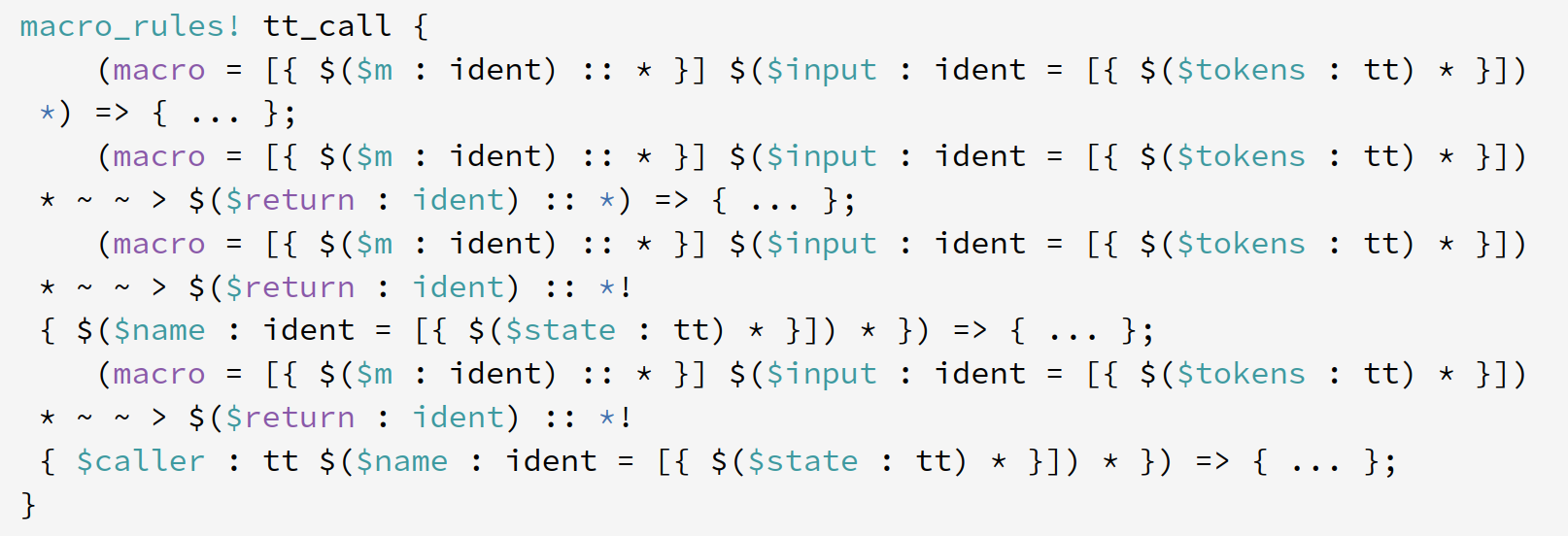by using an opaque type obligation to bubble up comparisons between opaque types and other types
Also uses proper obligation causes so that the body id works, because out of some reason nll uses body ids for logic instead of just diagnostics.
Render more readable macro matcher tokens in rustdoc
Follow-up to #92334.
This PR lifts some of the token rendering logic from https://github.com/dtolnay/prettyplease into rustdoc so that even the matchers for which a source code snippet is not available (because they are macro-generated, or any other reason) follow some baseline good assumptions about where the tokens in the macro matcher are appropriate to space.
The below screenshots show an example of the difference using one of the gnarliest macros I could find. Some things to notice:
- In the **before**, notice how a couple places break in between `$(....)`↵`*`, which is just about the worst possible place that it could break.
- In the **before**, the lines that wrapped are weirdly indented by 1 space of indentation relative to column 0. In the **after**, we use the typical way of block indenting in Rust syntax which is put the open/close delimiters on their own line and indent their contents by 4 spaces relative to the previous line (so 8 spaces relative to column 0, because the matcher itself is indented by 4 relative to the `macro_rules` header).
- In the **after**, macro_rules metavariables like `$tokens:tt` are kept together, which is how just about everybody writing Rust today writes them.
## Before

## After

r? `@camelid`
This is the same idea as #92533, but for `AssocItem` instead
of `VariantDef`/`FieldDef`.
With this change, we no longer have any uses of
`#[stable_hasher(project(...))]`
Replace use of `ty()` on term and use it in more places. This will allow more flexibility in the
future, but slightly worried it allows items which are consts which only accept types.
ProjectionPredicate should be able to handle both associated types and consts so this adds the
first step of that. It mainly just pipes types all the way down, not entirely sure how to handle
consts, but hopefully that'll come with time.
The field is also renamed from `ident` to `name. In most cases,
we don't actually need the `Span`. A new `ident` method is added
to `VariantDef` and `FieldDef`, which constructs the full `Ident`
using `tcx.def_ident_span()`. This method is used in the cases
where we actually need an `Ident`.
This makes incremental compilation properly track changes
to the `Span`, without all of the invalidations caused by storing
a `Span` directly via an `Ident`.
This commit removes the first of nine Clean impls on tuples, converting
it to a function instead.
The fact that these are impls causes several problems:
1. They are nameless, so it's unclear what they do.
2. It's hard to find where they're used apart from removing them and
seeing what errors occur (this applies to all Clean impls, not just
the tuple ones).
3. Rustc doesn't currently warn when impls are unused, so dead code
can accumulate easily (all Clean impls).
4. Their bodies often use tuple field indexing syntax (e.g., `self.1`)
to refer to their "arguments", which makes reading the code more
difficult.
As I noted, some of these problems apply to all Clean impls, but even
those problems are exacerbated by the tuple impls since they make
general understanding of the code harder.
Converting the impls to functions solves all four of these problems.
I would like to rename it to `Type::Path`, but then it can't be
re-exported since the name would conflict with the `Path` struct.
Usually enum variants are referred to using their qualified names in
Rust (and parts of rustdoc already do that with `clean::Type`), so this
is also more consistent with the language.
Avoid documenting top-level private imports
PR #88447 aimed to make rustdoc's `--document-private-items` mode only document imports that are visible outside the importing module. Unfortunately, I inadvertently set things up so that imports at the crate top-level are always documented, regardless of their visibility. This behavior was unintended and is [not desirable](https://github.com/rust-lang/rust/issues/90865#issuecomment-971172649).
This PR treats top-level imports as never being visible outside their parent module. In practice, the only way a top-level import can be visible externally is if it's fully public, and there's a seperate check for that.
It's worth calling attention to the fact that this change means that `pub(crate)` imports will be visible in lower level modules, but not at the top-level. This is because, at the top level of the crate, `pub(crate)` means the same thing as `pub(self)`.
It turned out that there were existing tests checking for the only behavior, which I didn't notice at the time of my previous PR. I have updated them to check for the new behavior and substantially extended them to handle differences between the top-level module and lower level modules. I may have gone overboard, so please tell me if there's anything I should cut.
r? `@jyn514`
Fixes#90865.
rustdoc: Replace where-bounded Clean impl with simple function
This is the first step in removing the Clean impls for tuples. Either way, this
significantly simplifies the code since it reduces the amount of "trait magic".
(To clarify, I'm referring to impls like `impl Clean for (A, B)`, not Clean impls
that work on tuples in the user's program.)
cc ``@jyn514``
This function parameter attribute was introduced in https://github.com/rust-lang/rust/pull/44866 as an intermediate step in implementing `impl Trait`, it's not necessary or used anywhere by itself.